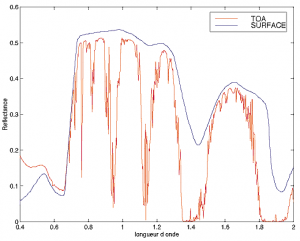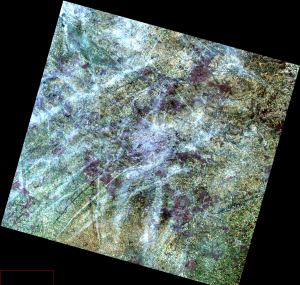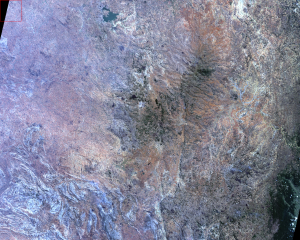
The LANDSAT-8 and SENTINEL-2 satellites have a spectral band centered on the 1.38µm wavelength, which is designed to allow the detection of high altitude clouds. This spectral band corresponds to a strong absorption band of water vapour. its absorption is so strong that a photon emitted by the sun in this wavelength has nearly no chance to reach the earth surface, and even less to reach the satellite after that without being absorbed. The consequence is therefore that the surface is usually not visible on the images taken for the 1.38 µm channel. However, as water vapour is concentrated in the lower layers of the atmosphere, the photons reflected by high clouds have much less chances to be absorbed. The 1.38 µm images display the higher parts of the atmosphere, and can be used to screen the high clouds, as it may be seen on the image below, on which a very large number of plane contrails may be observed (I counted 35, what about you ?) This spectral band is therefore useful to detect these thin cirrus clouds which, without this band, were usually difficult to spot and used to degrade our reflectances time series.
 |
 |
|---|
LANDSAT 8 image taken over Paris in April 2013. On the left, the RGB color composite, and on the right the 1.38µm channel. The plane contrails can be easily detected, and given their number, one can see that we might have to choose whether to fly or to observe…
It is just sad that a simple threshold cannot do the detection with a 100% accuracy (but if it was the case, cloud detection would be easy for everyone, and we would not be useful anymore !)First of all, the low clouds and the fog are very close to the surface and are not visible in that band. One has to use other criteria to detect them. Moreover, some mountains may emerge from the absorbing layers, all the more when the atmosphere is dry. A thresholding to detect high clouds must take into account the surface altitude, and for a better accuuracy, should take into account the waper vapour quantity and vertical repartition, which may be predicted using weather analyses.
 |
 |
|---|
Landsat 8 image taken above the center of Madagascar, in September 2013. On the left, the RGB color composite, and on the rght, the 1.38 µm channel. There is nearly no cloud on this image, but the surface reflectance is much greater than zero, because part or the region has an altitude above 1500m, and because the atmosphere was particularly dry on that day..
Finally, the 1.38µm channel is efficient to detect high clouds and especially thin cirrus, but has to be used with some precautions to avoid that all mountains be classified as high clouds. This is how we proceed in the MAJA processor.
